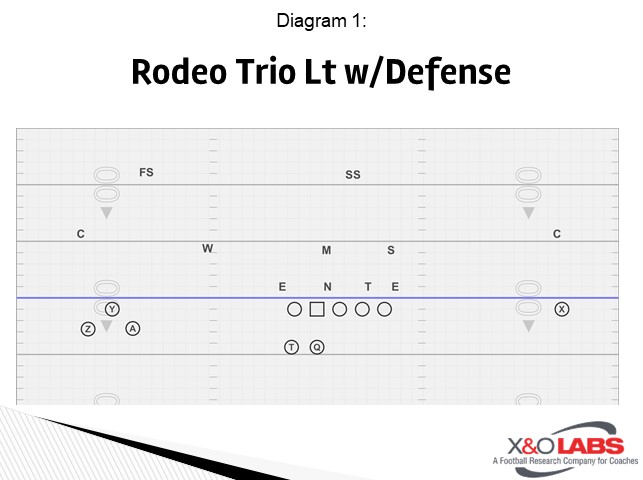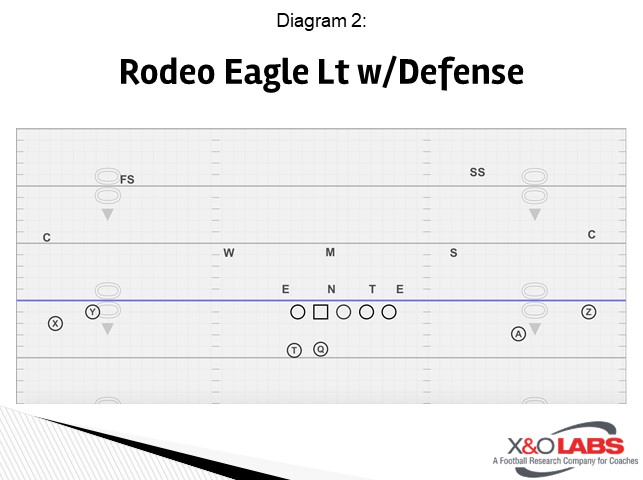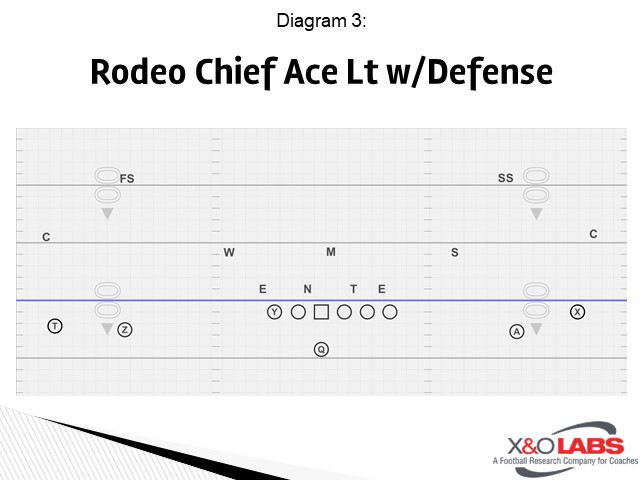By Thomas Hotmer
Head Coach
Princeton High School (MO)
Twitter: @coachhotmer, @PrincetonTFbal
Introduction
The unbalanced line in our spread offense allows us to create more leverage space on one side for our passing game and the other side for our running game. The idea is to create confusion on the defensive alignment up front. Diversifying the spread in a new way to create spacing and matchup advantages creates nightmares for opposing defensive coordinators. At the same time, our players enjoy the creativity each week learning a new wrinkle and enhances their focus on play design with individual responsibilities. While we did not use this in every game, the threat of using it requires opponents to use practice time learning how to line up to it rather than only focusing on our base plays.
Rodeo/Lasso (Tackle Over)
When implementing our tackle over package, the main priority is to ensure your tackle understands the run blocking rules from the tight end position. In our system, we have base blocking rules determined from the defensive alignment. We coach our lineman from the idea of where the run play is called and if they are covered or uncovered by a defensive lineman. Beyond this simple blocking concept, our tackles can go unbalanced as a tight end and still be effective blocking in our run game.
Once we started doing this, we noticed the extra spacing to the opposite side of our call based on the defensive shifts. We mainly utilized this to create more space for our passing game on the backside with all players keeping their eligibility and creating an extra gap for our running game on the overload side. The extra gap and 4-6 extra yards of space on the backside has given us the freedom to keep all of our plays the same with the ability to make the defense have to tackle well in more space. If we call a pass play, we run it as called. If we call a run play, we always tag it with an RPO so our quarterback can read pre-snap leverage. The following diagrams will present a few formation ideas that gave us leverage advantages for both our run and pass game RPO’s.

Rodeo Trio Lt Coaching Points:
When using this formation, the main thing I want to know is how they will defend us up front and the space they will allow to the trips receivers. If they do not shift with our tackle over, we will run the ball to that side. If the defense over shifts and gives us more space, I like to throw bubble or now screens as well as all verticals.

Rodeo Eagle Lt Coaching Points:
This formation allows for us to get into a spread look with our two best receivers on the same side. This allows us to avoid brackets on our two best receivers and create the one on one mismatch we like with the space they give us.

Rodeo Chief Ace Lt Coaching Points:
This formation allows our tight end to look like a left tackle in a trips set while maintaining eligibility. We can still run the ball with any run play we like as well as tag run pass options with this balanced line. We can get mismatches with a slot receiver on a linebacker or our tight end on a linebacker to take advantage of in the passing game.
To study game film of this formation structure, click on the videos below:
Editor’s Note: Coach Hotmer has provided clip by clip narration for each of these plays:
Clip 1: On this play, the defense does not shift to the tackle over. They choose to shade to the tight end that has been hurting them in the pass game with their defensive line, a linebacker, and a safety creating for an easy QB Iso to the tackle over. The key to this is maintaining eligibility with our receivers and tight ends so that the however the defense aligns, we can make them wrong.








